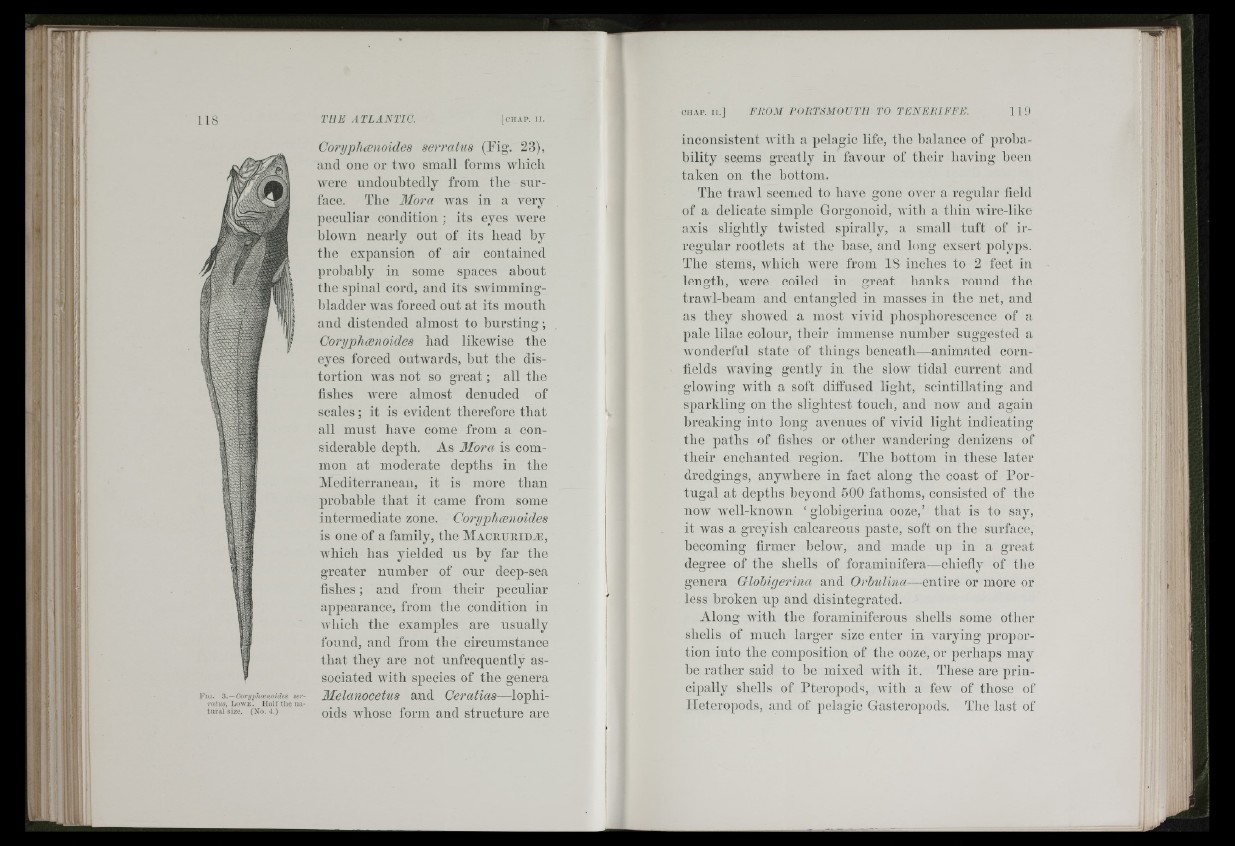
ill I
118 THE ATLANTIC. [c i IAF. II.
:!
t
I i
( I i
I !
! !
i
i: lid i I !:
if I
Fiu, 3. — Cor>jphcenoide.s ser-
ra tu s, Lowe. H a lf the na tu
ra l size. (No. 4.)
Corijpluenoides serratus (Eig. 23),
and one or two small forms which
AA'cre undoubtedly from the surface.
The Mora Avas in a Ai'cry
peculiar condition ; its eyes Avere
hloAvn nearly out of its head hy
the expansion of air contained
probably in some spaces about
the spinal cord, and its SAAdmming-
bladder Avas forced out at its mouth
and distended almost to bursting;
Coryplicenoides had likewise the
eyes forced oiitAvards, but the distortion
was not so great; all the
fishes AA^ere almost denuded of
scales; it is evident therefore that
all must have come from a considerable
deptb. As Mora is common
at moderate depths in the
Mediterranean, it is more than
probable that it came from some
intermediate zone. Corypliainoides
is one of a family, the Mace.uridh?,
Avhicli has yielded us by far the
greater number of onr deep-sea
fishes; and from tbeir peculiar
appearance, from the condition in
AAdiich the examples are usually
found, and from the circumstance
that they are not unfrequently associated
Avith species of the genera
Melanocetus and Ceratias— lophi-
oids Avliose form and structure are
CHAP. I I .] FROM FORTSMOUTll TO TENERIFFE. 11!)
inconsistent Avith a pelagic life, tlie balance of probability
seems greatly in favour of their having heen
taken on the bottom.
The traAvl seemed to liave gone over a regular field
of a delicate simple Gorgonoid, Avith a tliin Avire-like
axis slightly tAvisted spirally, a small tuft of irregular
rootlets at the base, and long exsert polyps.
The stems, Avhich Avere from IS inches to 2 feet in
length, Avere coiled in great hanks round the
traAAd-heam and entangled in masses in the net, and
as they shoAved a most vivid phosphorescence of a
pale lilac colour, tbeir immense number suggested a
AA'onderfnl state of things beneath—animated cornfields
Avaving gently in the sloAV tidal current and
glowing Avitli a soft diffused light, scintillating and
sparkling on the slightest touch, and noAV and again
breaking into long aA^enues of vivid light indicating
the paths of fishes or other Avandering denizens of
their enchanted region. The bottom in these later
dredgings, anyAvbere in fact along the coast of I’or-
tugal at depths beyond 500 fathoms, consisted of the
now Avell-knoAvn ‘ glohigerina ooze,’ that is to say,
it Avas a greyish calcareous paste, soft on the surface,
becoming firmer heloAV, and made up in a great
degree of the shells of foraminifera—chiefly of the
genera Glohigerina and Orhulina— entire or more or
less broken up and disintegrated.
Along Avitli tbe foraminiferous shells some otlier
shells of much larger size enter in varying proportion
into the composition of the ooze, or perhaps may
be rather said to be mixed Avith it. These are principally
shells of Pteropod«!, Avith a feAv of those of
lieteropods, and of pelagic Gasteropods. The last of
A kill
k k i
' 1?,
Ei,
tvli»
I
f!:
i]/ : -w
(1 : 4,....'::.
..ii -
; :!'
M